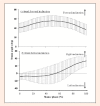The Relationship between Performance and Trunk Movement During Change of Direction
- PMID: 24149303
- PMCID: PMC3737904
The Relationship between Performance and Trunk Movement During Change of Direction
Abstract
The purpose of this study was to obtain the trunk kinematics data during a change-of-direction task and to determine the relationship between trunk kinematics and the change-of-direction performance. The design of this investigation was a descriptive laboratory study. Twelve healthy male collegiate soccer players (age: 21.3 ± 1.0 yrs, body mass: 67. 7 ± 6.7 kg, and height: 1.75 ± 0.05 m) participated in this study. Participants performed a shuttle run cutting task with a 180 degree pivot as quickly as possible. The shuttle run cutting time, ground contact time during a change-of-direction, and trunk inclination angle were measured. The shuttle run cutting time tends to correlate positively with ground contact time. During the change- of-direction task, the trunk forward inclination angle gradually increased during the first 50% of the stance phase and decreased subsequently whereas the trunk flexed, maintaining a left inclination during the first 40% of the stance phase and changing exponentially in the opposite direction. Forward angular displacement of the trunk between foot-contact and maximum trunk inclination correlated positively with the shuttle run cutting time (r = 0.61, p < 0.05) and ground contact time (r = 0.65, p < 0.05). These findings suggest that the change-of-direction performance could be related to the small angular displacement of the trunk during a change of direction. Moreover, it was considered that there might be optimal inclination angles related to change-of-direction performance. Therefore, coaches in field sports should check body posture and trunk movements during changes of direction. Key pointsSmall forward angular displacement of the trunk during a direction change is related to the change-of-direction performance.Trunk stability during a change of direction is an important factor in the change-of-direction performance.There might be a range of optimal angles of trunk inclination during a change of direction.Coaches in field sports should check the body posture and trunk movement of players when they require a change of direction or when they participate in sport-specific change-of-direction training.
Keywords: Kinematics; angular displacement; field sports; posture, stability.
Figures



Similar articles
-
Relationship between three-dimensional kinematics of knee and trunk motion during shuttle run cutting.J Sports Sci. 2011 Nov;29(14):1525-34. doi: 10.1080/02640414.2011.599038. Epub 2011 Oct 12. J Sports Sci. 2011. PMID: 21988136
-
Influence of Anticipation and Motor-Motor Task Performance on Cutting Biomechanics in Healthy Men.J Athl Train. 2020 Aug 1;55(8):834-842. doi: 10.4085/1062-6050-569-18. J Athl Train. 2020. PMID: 32688389 Free PMC article.
-
Differences in neuromuscular strategies between landing and cutting tasks in female basketball and soccer athletes.J Athl Train. 2006 Jan-Mar;41(1):67-73. J Athl Train. 2006. PMID: 16619097 Free PMC article.
-
Prevention of non-contact anterior cruciate ligament injuries in soccer players. Part 1: Mechanisms of injury and underlying risk factors.Knee Surg Sports Traumatol Arthrosc. 2009 Jul;17(7):705-29. doi: 10.1007/s00167-009-0813-1. Epub 2009 May 19. Knee Surg Sports Traumatol Arthrosc. 2009. PMID: 19452139 Review.
-
Biomechanical Determinants of Knee Joint Loads Associated with Increased Anterior Cruciate Ligament Loading During Cutting: A Systematic Review and Technical Framework.Sports Med Open. 2020 Nov 2;6(1):53. doi: 10.1186/s40798-020-00276-5. Sports Med Open. 2020. PMID: 33136207 Free PMC article. Review.
Cited by
-
The Effect of Angle and Velocity on Change of Direction Biomechanics: An Angle-Velocity Trade-Off.Sports Med. 2018 Oct;48(10):2235-2253. doi: 10.1007/s40279-018-0968-3. Sports Med. 2018. PMID: 30094799 Free PMC article. Review.
-
Change of Direction Deficit: A Promising Method to Measure a Change of Direction Ability in Adolescent Basketball Players.J Hum Kinet. 2023 Jan 4;85:1-11. doi: 10.2478/hukin-2022-0105. eCollection 2022 Dec. J Hum Kinet. 2023. PMID: 36643838 Free PMC article.
-
Can Sports Practice in Childhood and Adolescence Be Associated with Higher Intensities of Physical Activity in Adult Life? A Retrospective Study in Community-Dwelling Adults.Int J Environ Res Public Health. 2022 Nov 10;19(22):14753. doi: 10.3390/ijerph192214753. Int J Environ Res Public Health. 2022. PMID: 36429475 Free PMC article.
-
Biomechanical Determinants of Performance and Injury Risk During Cutting: A Performance-Injury Conflict?Sports Med. 2021 Sep;51(9):1983-1998. doi: 10.1007/s40279-021-01448-3. Epub 2021 Apr 3. Sports Med. 2021. PMID: 33811615 Free PMC article.
-
Association of Performance in Strength and Plyometric Tests with Change of Direction Performance in Young Female Team-Sport Athletes.J Funct Morphol Kinesiol. 2021 Oct 14;6(4):83. doi: 10.3390/jfmk6040083. J Funct Morphol Kinesiol. 2021. PMID: 34698245 Free PMC article.
References
-
- Andriacchi T.P., Alexander E.J., Toney M.K., Dyrby C., Sum J. (1998) A point cluster method for in vivo motion analysis; applied to a study of knee kinematics. Journal of Biomechanical Engineering 120, 743-749 - PubMed
-
- Brughelli M., Cronin J., Levin G., Chaouachi A. (2008) Understanding change of direction ability in sport: a review of resistance training studies. Sports Medicine 38(12), 1045-1063 - PubMed
-
- Carling C., Reilly T, Williams M.A. (2009) Performance assessment for field sports. Routledge, Oxford
-
- Chaudhari A.M., Hearn B.K., Andriacchi T.P. (2005) Sport-dependent variations in arm position during single-limb landing influence knee loading: implications for anterior cruciate ligament injury. The American Journal of Sports Medicine 33(6), 824-830 - PubMed
LinkOut - more resources
Full Text Sources
